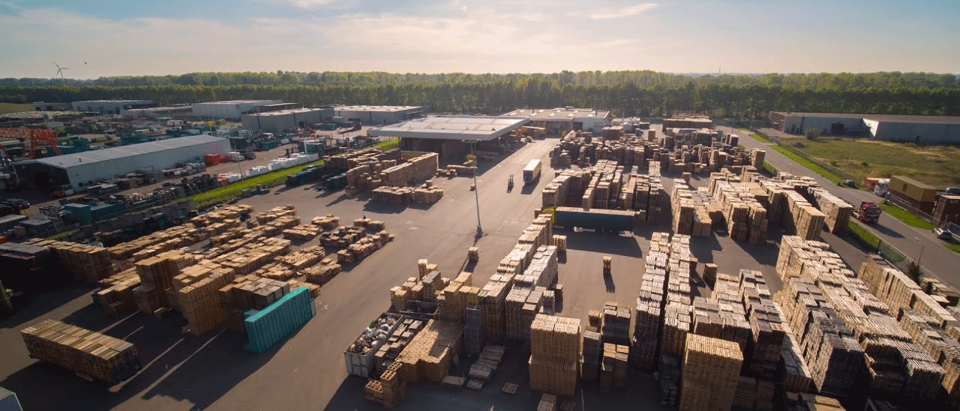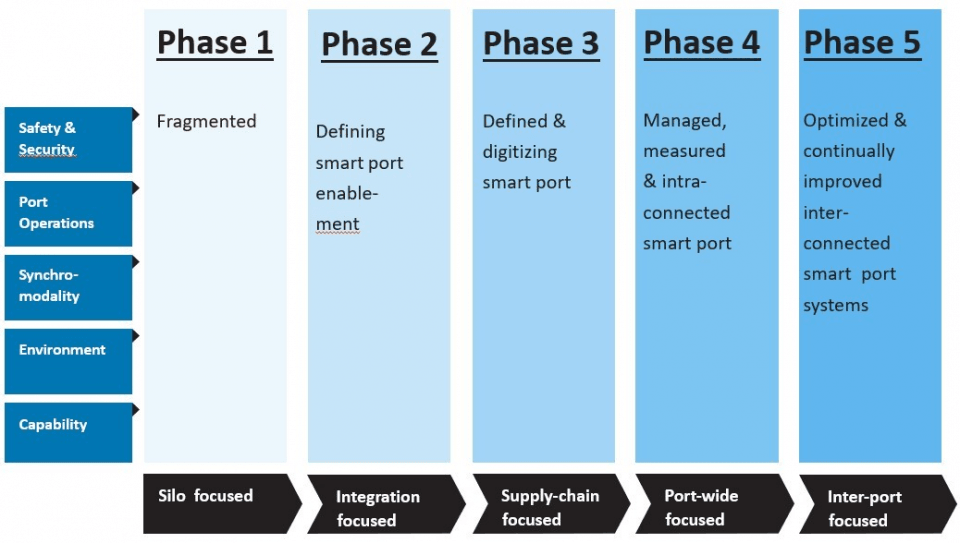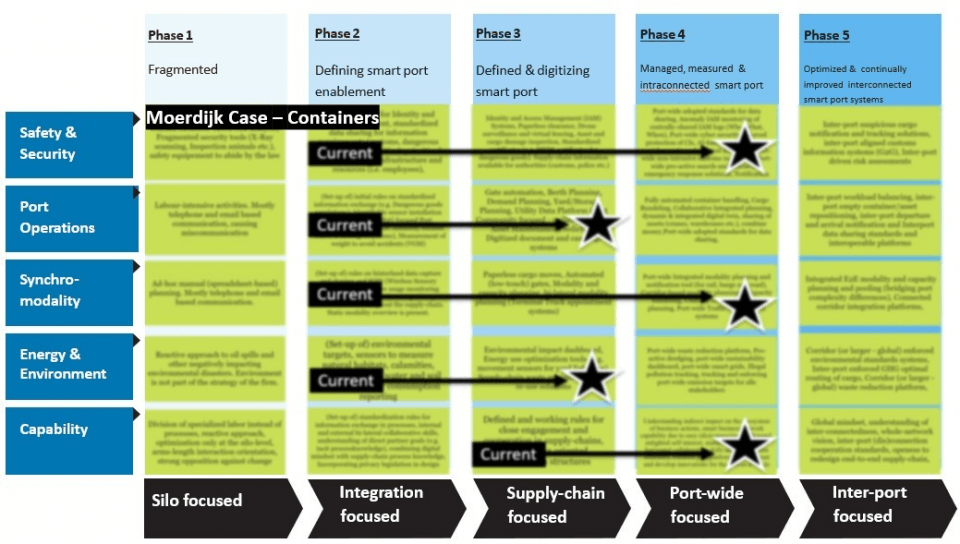Driving strategic alignment and collaborative innovation with the Smart Port Maturity Model: The Port of Moerdijk case
Industry 4.0 is advancing the adoption of radically new technologies, business models and profit pools across industries. For logistics, securing a share of these new profit pools will be crucial, as its commoditized business is under pressure from increasing price competition and new entry from e-commerce giants. Consolidation in the middle of the chain has extended the lifespan of the old transactional business models for the large players, while it threatens the profit potential for 99% of the actors in the chain.
The Case of the Port of Moerdijk
 This physical consolidation has recently been complemented by digital platform-based consolidation, cf. the IBM-Maersk Tradelens platform. Platform economics will create new centers of power in supply chains and enable new modes of digital value creation. Yet, the strategic question for the coming three years is who will take ownership of these new positions: port ecosystems, the large carrier alliances who already own most of the global cargo flows, or outsiders who dwarf even these carrier alliances?
This physical consolidation has recently been complemented by digital platform-based consolidation, cf. the IBM-Maersk Tradelens platform. Platform economics will create new centers of power in supply chains and enable new modes of digital value creation. Yet, the strategic question for the coming three years is who will take ownership of these new positions: port ecosystems, the large carrier alliances who already own most of the global cargo flows, or outsiders who dwarf even these carrier alliances?
Necessity of global digital supply chain networks
Those port communities who are only now embracing the platform revolution behind the success of 6 out of the 10 largest companies in the world, are late to the party. Yet, they may still avoid a ‘boiling frog’ fate when digital disruptors either cut them out of the chain or reduce them to mere physical service vassals. Leaders in each type of logistics business need to start asking themselves what if Amazon, AliBaba or Uber start doing what I do? If the answer is that your entire business model is built around shielding-off data from the value chain or on a physical location in a hub or corridor that is poorly connected with global digital supply chain networks, you will face disruption soon.
The case of the Port of Moerdijk
 Port authorities are increasingly getting to grasps with this new reality and seek to lead their communities into the digital era. Many of them have made it a strategic priority to focus on digital community-building, as well as the use of a new generation of data aggregation platforms. The Port of Moerdijk, a mid-sized inland port between Rotterdam and Antwerp is no different. The port is a relatively diversified community with just over 400 companies. Moerdijk port authority feels a push to innovate, both from this community and from the Portbase platform it is linked to. Despite already being active in several innovation projects with their community members, a need was felt to adopt a systematic approach to drive ROI and align with the demands of the port community. This is why the Smart Port Maturity Model was introduced.
Port authorities are increasingly getting to grasps with this new reality and seek to lead their communities into the digital era. Many of them have made it a strategic priority to focus on digital community-building, as well as the use of a new generation of data aggregation platforms. The Port of Moerdijk, a mid-sized inland port between Rotterdam and Antwerp is no different. The port is a relatively diversified community with just over 400 companies. Moerdijk port authority feels a push to innovate, both from this community and from the Portbase platform it is linked to. Despite already being active in several innovation projects with their community members, a need was felt to adopt a systematic approach to drive ROI and align with the demands of the port community. This is why the Smart Port Maturity Model was introduced.
Enter the Smart Port Maturity Model
The move towards Smarter Ports in Europe is being led by port authorities as natural custodians of their communities’ data aggregation, but requires integrated community efforts. At the same time, the sheer number of possible smart port applications to focus on makes it hard to develop a focused innovation roadmap. The AMS Smart Ecosystems & Networks team has developed the Smart Port Maturity Model™ (SPMM) to deal with those issues and facilitate communal innovation roadmapping.
The framework was inspired by a preceding analysis that identified all the known smart port application types into 22 application type clusters. To provide direction in this diverse opportunity landscape of new data-based, IoT, blockchain or other technology-based applications in ports, the model maps these 22 application type clusters on key smart port dimensions and maturity levels.
 Figure 1 – Dimensions and phases of the smart port maturity framework
Figure 1 – Dimensions and phases of the smart port maturity framework
The SPMM’s 5 smart port domains are as follows:
- Safety, security & governance: solutions for the reliable operation of port areas, cargo, information and people
- Port operations: solutions for efficient and resilient in- and port-bound flows
- Synchro-modality: solutions for optimized multi-modal out-bound flows
- Environment & Energy: sustainability of activities and the means for those activities.
- Capability: the required framework conditions (e.g. mindsets, business models, resource bases) to enable collaborative digital innovation
The data integration phases are used to evaluate the current and desired state of smart port capability in each dimension and are:
- Phase 1 – fragmentated silo-ed data streams
- Phase 2 – developing the necessary building blocks for data integration
- Phase 3 – defining and digitalizing through smart port solutions
- Phase 4 – implementing inter-connected smart port solutions
- Phase 5 – real-time cross- stakeholders optimization based on data

The results for Moerdijk - Defining the digital transformation ambitions – together
The Smart Port Maturity Model™ was used in the port of Moerdijk to assess the maturity of its community on the five dimensions, and to involve the community in developing an innovation horizon in each of those dimensions. Working together with the community was the logical step for the port authority, as it owns just 10% of the port area and thus has a tradition of consulting its private community. Even though the port already has a well-developed collaborative tradition, the co-definition of innovation priorities with the community took this one step further.
As part of the pilot workshop, the participants defined a perceived current maturity level, as well as a desired ambition level, on each of the five of smart port maturity domains. Mapping both the as-is situation and the desired state on each of the domains, helped define a roadmap of short, medium and long-term goals to reach their shared aspirational maturity phase. The mapping onto the 22 smart port application types made it easier to define concrete next steps, as each maturity phase corresponds with specific systems, data points and user interfaces per domain.
 Figure 2 - Outcome strategic maturity mapping port of Moerdijk: current versus aspired levels
Figure 2 - Outcome strategic maturity mapping port of Moerdijk: current versus aspired levels
The use of the SPMM created a shared understanding on what the current state is and what the shared ambition is for their port. The participants were challenged to adopt a new way of thinking - in terms of community goals instead of simple company goals.
In essence, the smart port maturity framework is an Interreg-sponsored tool aimed at helping port communities to:
1. Guide individual actors and port communities in their digital transformation. The extensive review of academic as well as practical literature provides a sound basis to inspire you on opportunities.
2. Map their current maturity and benchmark it against peers. Digital maturity is a competitive advantage, allowing your port and company to compete on services instead of (decreasing) prices.
3. Strategically align your port community to choose digital transformation projects together. Successful collaborative port innovations are few and far between, and a shared foundation is a necessary first step that many fail to take. The SPMM builds the necessary port community commitment base to implementing collaborative digital innovation projects.
Want to find out more about the SPMM™ framework and how it might be useful to you? Visit our website or send us an email – we’d love to discuss your smart port ambitions over a nice cup of coffee!

comments0
You don't have the rights to read or add a comment.
Suggested Articles

